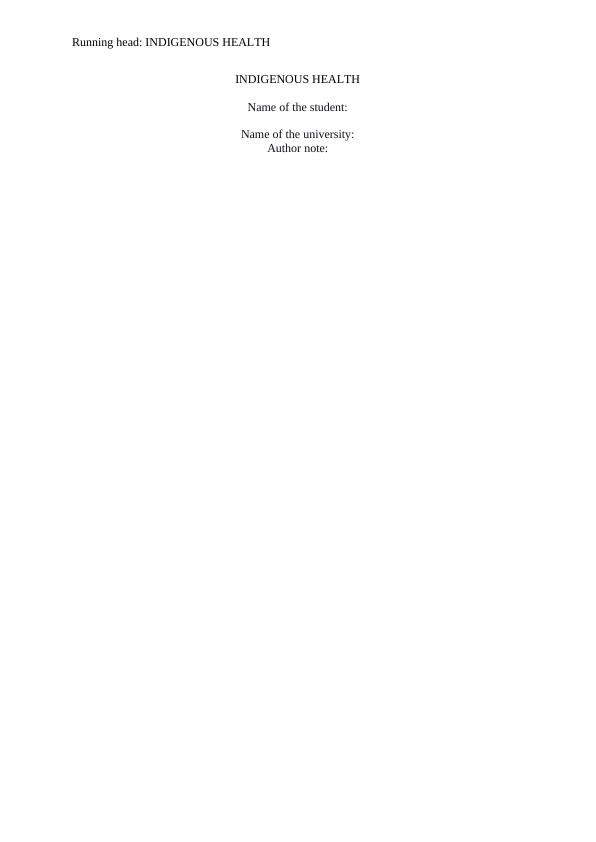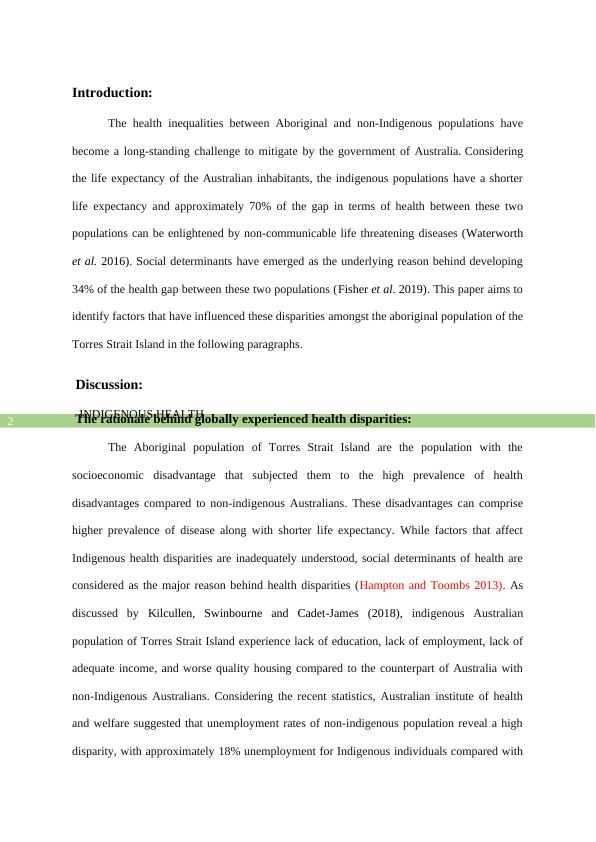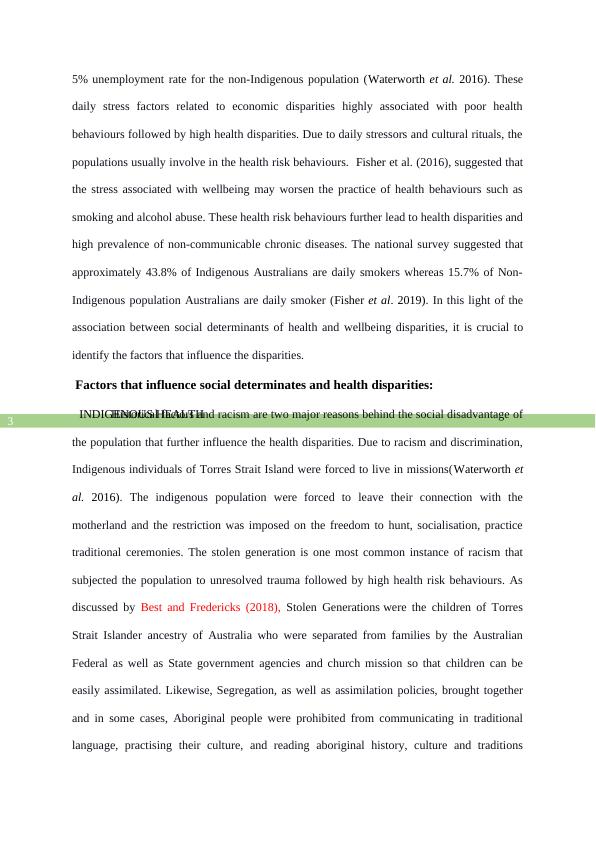Health Inequalities Between Aboriginal and Non-Indigenous Populations
Added on 2022-08-21
6 Pages1262 Words17 Views
Running head: INDIGENOUS HEALTH
INDIGENOUS HEALTH
Name of the student:
Name of the university:
Author note:
INDIGENOUS HEALTH
Name of the student:
Name of the university:
Author note:

INDIGENOUS HEALTH
2
Introduction:
The health inequalities between Aboriginal and non-Indigenous populations have
become a long-standing challenge to mitigate by the government of Australia. Considering
the life expectancy of the Australian inhabitants, the indigenous populations have a shorter
life expectancy and approximately 70% of the gap in terms of health between these two
populations can be enlightened by non-communicable life threatening diseases (Waterworth
et al. 2016). Social determinants have emerged as the underlying reason behind developing
34% of the health gap between these two populations (Fisher et al. 2019). This paper aims to
identify factors that have influenced these disparities amongst the aboriginal population of the
Torres Strait Island in the following paragraphs.
Discussion:
The rationale behind globally experienced health disparities:
The Aboriginal population of Torres Strait Island are the population with the
socioeconomic disadvantage that subjected them to the high prevalence of health
disadvantages compared to non-indigenous Australians. These disadvantages can comprise
higher prevalence of disease along with shorter life expectancy. While factors that affect
Indigenous health disparities are inadequately understood, social determinants of health are
considered as the major reason behind health disparities (Hampton and Toombs 2013). As
discussed by Kilcullen, Swinbourne and Cadet‐James (2018), indigenous Australian
population of Torres Strait Island experience lack of education, lack of employment, lack of
adequate income, and worse quality housing compared to the counterpart of Australia with
non-Indigenous Australians. Considering the recent statistics, Australian institute of health
and welfare suggested that unemployment rates of non-indigenous population reveal a high
disparity, with approximately 18% unemployment for Indigenous individuals compared with
2
Introduction:
The health inequalities between Aboriginal and non-Indigenous populations have
become a long-standing challenge to mitigate by the government of Australia. Considering
the life expectancy of the Australian inhabitants, the indigenous populations have a shorter
life expectancy and approximately 70% of the gap in terms of health between these two
populations can be enlightened by non-communicable life threatening diseases (Waterworth
et al. 2016). Social determinants have emerged as the underlying reason behind developing
34% of the health gap between these two populations (Fisher et al. 2019). This paper aims to
identify factors that have influenced these disparities amongst the aboriginal population of the
Torres Strait Island in the following paragraphs.
Discussion:
The rationale behind globally experienced health disparities:
The Aboriginal population of Torres Strait Island are the population with the
socioeconomic disadvantage that subjected them to the high prevalence of health
disadvantages compared to non-indigenous Australians. These disadvantages can comprise
higher prevalence of disease along with shorter life expectancy. While factors that affect
Indigenous health disparities are inadequately understood, social determinants of health are
considered as the major reason behind health disparities (Hampton and Toombs 2013). As
discussed by Kilcullen, Swinbourne and Cadet‐James (2018), indigenous Australian
population of Torres Strait Island experience lack of education, lack of employment, lack of
adequate income, and worse quality housing compared to the counterpart of Australia with
non-Indigenous Australians. Considering the recent statistics, Australian institute of health
and welfare suggested that unemployment rates of non-indigenous population reveal a high
disparity, with approximately 18% unemployment for Indigenous individuals compared with

INDIGENOUS HEALTH
3
5% unemployment rate for the non-Indigenous population (Waterworth et al. 2016). These
daily stress factors related to economic disparities highly associated with poor health
behaviours followed by high health disparities. Due to daily stressors and cultural rituals, the
populations usually involve in the health risk behaviours. Fisher et al. (2016), suggested that
the stress associated with wellbeing may worsen the practice of health behaviours such as
smoking and alcohol abuse. These health risk behaviours further lead to health disparities and
high prevalence of non-communicable chronic diseases. The national survey suggested that
approximately 43.8% of Indigenous Australians are daily smokers whereas 15.7% of Non-
Indigenous population Australians are daily smoker (Fisher et al. 2019). In this light of the
association between social determinants of health and wellbeing disparities, it is crucial to
identify the factors that influence the disparities.
Factors that influence social determinates and health disparities:
Historical factors and racism are two major reasons behind the social disadvantage of
the population that further influence the health disparities. Due to racism and discrimination,
Indigenous individuals of Torres Strait Island were forced to live in missions(Waterworth et
al. 2016). The indigenous population were forced to leave their connection with the
motherland and the restriction was imposed on the freedom to hunt, socialisation, practice
traditional ceremonies. The stolen generation is one most common instance of racism that
subjected the population to unresolved trauma followed by high health risk behaviours. As
discussed by Best and Fredericks (2018), Stolen Generations were the children of Torres
Strait Islander ancestry of Australia who were separated from families by the Australian
Federal as well as State government agencies and church mission so that children can be
easily assimilated. Likewise, Segregation, as well as assimilation policies, brought together
and in some cases, Aboriginal people were prohibited from communicating in traditional
language, practising their culture, and reading aboriginal history, culture and traditions
3
5% unemployment rate for the non-Indigenous population (Waterworth et al. 2016). These
daily stress factors related to economic disparities highly associated with poor health
behaviours followed by high health disparities. Due to daily stressors and cultural rituals, the
populations usually involve in the health risk behaviours. Fisher et al. (2016), suggested that
the stress associated with wellbeing may worsen the practice of health behaviours such as
smoking and alcohol abuse. These health risk behaviours further lead to health disparities and
high prevalence of non-communicable chronic diseases. The national survey suggested that
approximately 43.8% of Indigenous Australians are daily smokers whereas 15.7% of Non-
Indigenous population Australians are daily smoker (Fisher et al. 2019). In this light of the
association between social determinants of health and wellbeing disparities, it is crucial to
identify the factors that influence the disparities.
Factors that influence social determinates and health disparities:
Historical factors and racism are two major reasons behind the social disadvantage of
the population that further influence the health disparities. Due to racism and discrimination,
Indigenous individuals of Torres Strait Island were forced to live in missions(Waterworth et
al. 2016). The indigenous population were forced to leave their connection with the
motherland and the restriction was imposed on the freedom to hunt, socialisation, practice
traditional ceremonies. The stolen generation is one most common instance of racism that
subjected the population to unresolved trauma followed by high health risk behaviours. As
discussed by Best and Fredericks (2018), Stolen Generations were the children of Torres
Strait Islander ancestry of Australia who were separated from families by the Australian
Federal as well as State government agencies and church mission so that children can be
easily assimilated. Likewise, Segregation, as well as assimilation policies, brought together
and in some cases, Aboriginal people were prohibited from communicating in traditional
language, practising their culture, and reading aboriginal history, culture and traditions

End of preview
Want to access all the pages? Upload your documents or become a member.
Related Documents
12. Introduction. Vulnerability among the indigenous anlg...
|14
|4167
|12
The health and welfare of Australia's Aboriginallg...
|3
|578
|14
Factors resulting to health disparity between indigenous and non-indigenous communitieslg...
|16
|3191
|420
Indigenous Health Perspectives | Studylg...
|3
|430
|26
Health Promotion Analysis Reportlg...
|15
|3165
|36
Racism as the Social Determinant of Health | Reportlg...
|6
|1240
|11
